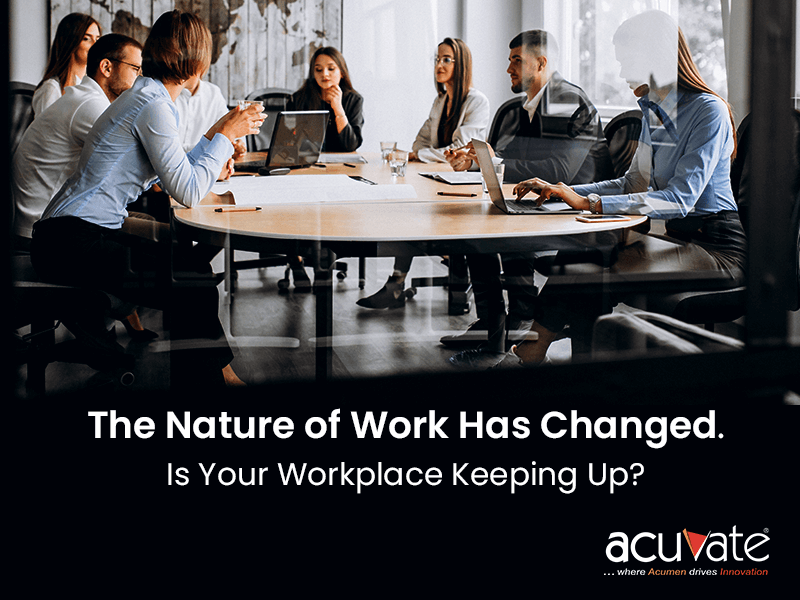Productivity, Collaboration, and Security – everywhere, anytime
When discussing workplace technology, it is always going to be before and after 2020. The sheer magnitude of changes that the pandemic has forced on organizations this past year has only highlighted what has been evident for a long time.
Even as businesses embrace technology to stay competitive and grow revenues, they are also focused on empowering their employees for the post-pandemic workplace.
The challenges of the traditional infrastructure centered workplace had already been evident in the last few years as organizations realized the futility of technology-focused evolution. Whether they wanted to increase storage or add an extra feature to applications, the IT departments would have to undertake extensive upgrades that would invariably disrupt end-user and workforce experience. Most such releases would also be too expensive to make much financial sense either. The major reasons why modernization is inevitable for organizations:
1. Inefficient infrastructure
Legacy systems and on-premise infrastructure keeps growing to meet specific dynamic business needs. This leads to disjointed infrastructure and content which slows down processes and systems.
2. Dated service offerings
Enterprise infrastructure is rigid and inflexible, hindering innovation and growth. On-premises infrastructure is not scalable, so they are not able to handle increasing demands when the organization expands into new products or markets.
3. Expensive contracts and licenses
Maintaining and regular upgrading of hardware is an expensive proposition. Every upgrade is a lengthy process that costs money, time, and more importantly, affects productivity.
4. Frustrated employee experience
Organizations do not allow employees complete access to information and systems via their personal devices to ensure uncompromised security. But this hinders collaboration and complicates processes for the employees, who have to catch up with the company information, tools, and resources only when they are in office.
5. Disorganized content & data
In the absence of proper data management regulations, organizations build up a huge pile of content which makes it very difficult to identify and access by the employees.
That is why when the pandemic pushed the global workforce into remote and hybrid environments, it was only accelerating the inevitable and the long overdue workplace modernization.
What makes a Workplace modern?
A modern workplace is a hybrid of digital and physical spaces that addresses business and employee needs in a unified, cohesive manner to enable collaboration and teamwork.
1. Digital-driven, connected workplaces
Modern workplaces are not limited to physical offices of the organization, but bring together physical and digital spaces seamlessly to create a connected, accessible, and sustainable solution with intelligent facilities and powerful tools that spark innovation, promote transparency, foster community, and drive productivity
2. Comprehensive User support
IT departments were the gatekeepers of information and employee experience in traditional systems since they decided the migration schedules and system functionalities. Employees had to follow lengthy processes to access even urgent information or make small upgrades to their tools. A modern workplace is built around providing employees swift and unobtrusive support experience across applications, virtual agents, social media, etc. without interrupting employee productivity.
3. Seamless access
Whether the employee is looking for information on people, files, or answers to specific questions, it should be easily discoverable and contextually integrated in their everyday use. By identifying search intent rather than file names, users should be able to access relevant and accurate information from across the entire organizational data.
3. Seamless access
A modern workplace should provide employees all the tools that they would need to complete common tasks quickly and easily. Employees would be able to receive well-placed, easily discoverable solutions for automating their tasks, as well as interact with digital assistants from anywhere in the system to guide them accurately to their requirements.
Microsoft 365 – Redefining employee experience for a changing world
Microsoft Modern Workplace, or the Microsoft 365, is an ecosystem of the latest technologies built to boost employee communication, collaboration, and productivity. It brings the immense opportunities and benefits of the Cloud to the end user, including scalability, reliability, and high availability.
The shift away from infrastructure centered technology solutions enables greater functionality and much better usability, since organizations do not have to handle infrastructure maintenance in-house. Employees are more empowered than ever as they can access all the data and applications they require right from their device, wherever they are, without being tied down to their workplace.
The impact of Microsoft 365 on modernization of the workplace can be highlighted in the following areas:
1. Productivity
Comprehensive IT management and deployment strategy as per specific business goals helps to accelerate growth. Consistent communication, unified data management and access, and analytical tools empower employees for faster and better data-driven decision making across the board.
2. Enhanced Collaboration capabilities
Streamlined workplace for collaboration where different teams can meet, call, and chat since the self-service capabilities prevent migrations from disrupting employee experience. Users are also connected through the latest tools to automate tedious and manual tasks.
3. Complete Security
Reduce risks and costs by consolidating to a single platform and reducing overall risk exposure. Security teams have better tools to coordinate protection, detection, response, and prevention of threats with a single solution.
Microsoft 365 modernization also ensures total compliance across the system.
Conclusion
Workplace modernization has evolved from a nice-to-have to must-have in response to huge shift we have witnessed last year in how we work. Migrating from legacy infrastructure to cloud is now critical to staying competitive in the market and to pursuing business goals more efficiently.
Digital technologies are poised to continue their significant growth in all aspects – social, mobile, analytics, and cloud, which will create new employee and customer experiences. The new business models and evolving processes with Microsoft 365 solutions will empower digital transformation for the workplace, for the employees, and for the users. Organizations should embrace the potential of digital workplace transformation with Microsoft 365’s advanced solutions for transforming workforce and customer experiences, create data-driven business models, and build intelligent and automated operations that are secure, compliant, and trusted.



